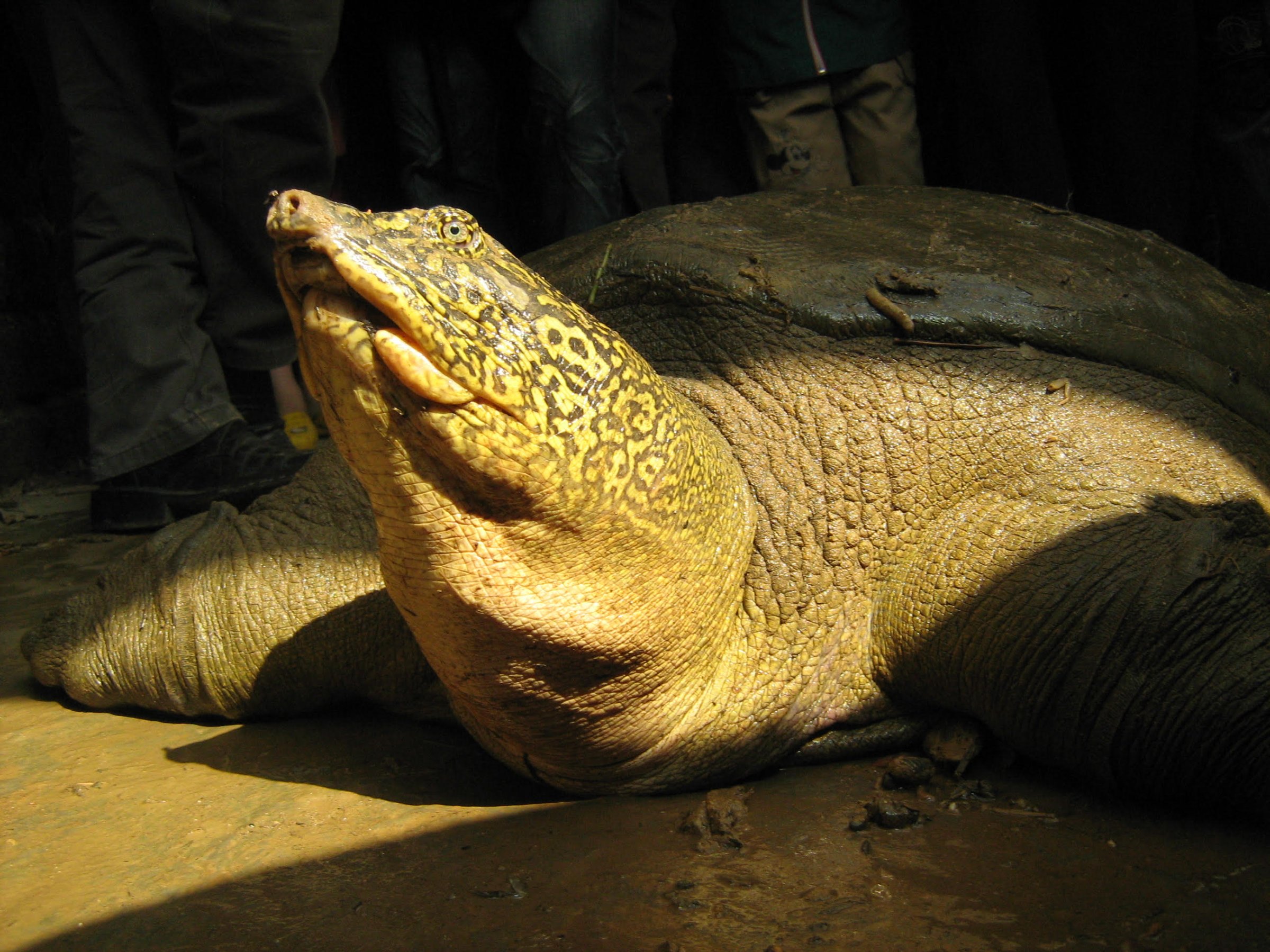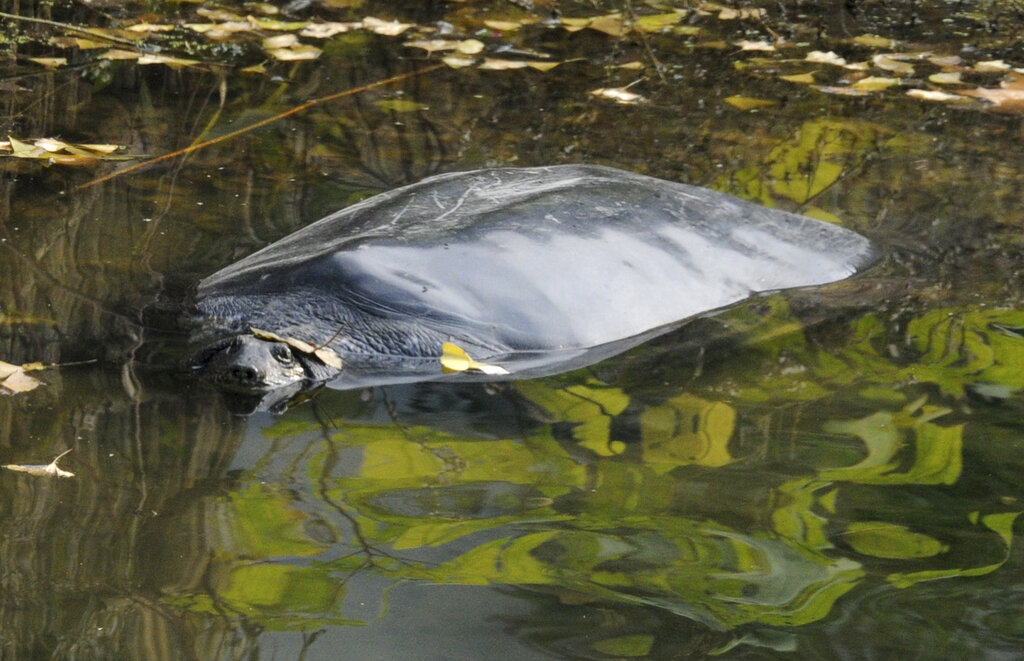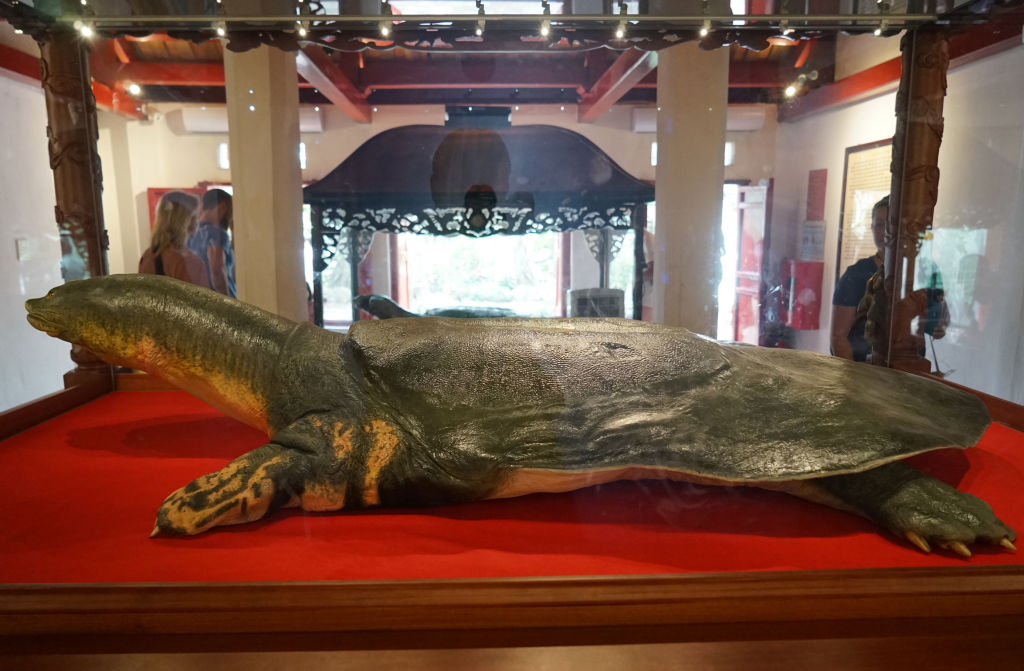
A dark oblong creature drifted from the depths of Hanoi’s 1,400-hectare Đồng Mô Lake and began to float, motionless, on the surface last weekend. Local residents and conservationists locked eyes on the gloomy sight, sharing fears about what this might mean for the future of a revered species in Vietnam.
On Monday, state media reports suggested it was not only a Giant Yangtze Softshell Turtle (Rafetus swinhoei), but it was likely the last known female of the species, leaving only two known males remaining—one in Suzhou Zoo in China and another in Hanoi’s Xuân Khanh Lake.
Speaking to TIME on Friday, Tim McCormack, director of the Asian Turtle Program for Indo-Myanmar Conservation, confirmed that the creature was almost certainly the last known female Rafetus swinhoei: “It is the same individual that we’ve been monitoring in recent years. It’s a real blow,” he said, noting that local authorities will soon complete a genetic test of the carcass to verify its identity. “It was a large female that obviously has great reproductive capacity. She could have potentially laid a hundred eggs or more a year.”
News reports suggest that the reptile, which is 156 centimeters long and weighs 93 kilograms, could have died days before it was spotted by locals. The cause of death remains unknown, as local authorities are yet to carry out a full autopsy.
More from TIME
The discovery of the female in January 2021 had raised hopes that the species could be saved from extinction. The reptile, also known as the Hoàn Kiếm turtle, has been driven to the brink of disappearance by rising levels of pollution as well as decades of hunting for its meat and eggs.
Previously, there was another female Giant Yangtze Softshell Turtle in Suzhou Zoo in China, but it died amid breeding efforts in 2018. For many years, staff tried unsuccessfully to get the pair of turtles at the zoo to reproduce naturally.

“The whole time, in 20 years I’ve been working with the species, we’ve never seen any eggs,” McCormack added. “There has been an artificial nesting beach built in Đồng Mô Lake for almost 10 years now, which has had no nesting. So one of the questions has been whether this was a lone animal or whether there are other animals in Đồng Mô.”
According to the Asian Turtle Program, there may be another Rafetus swinhoei living in Đồng Mô Lake, which gives conservationists reason to not give up on the species yet. But to date, scientists have only managed to catch and identify the one female.
“We’re also working at Xuân Khanh Lake in Hanoi, where environmental DNA has confirmed there is a male Rafetus,” McCormack said, adding that there is a need to capture and identify the reptile.
A revered creature
The Hoàn Kiếm turtle is of great spiritual importance in Vietnam. In the 15th century, according to Vietnamese mythology, a turtle in Hoàn Kiếm Lake gifted a sword to emperor Lê Lợi, which he used to vanquish occupying Chinese forces.
Khoi Pham, the editor of arts and culture magazine Saigoneer, tells TIME: “The fact that Rafetus swinhoei’s natural habitat overlaps with the story’s location elevates the species’ cultural significance in the eyes of Vietnamese. It’s like we have a tangible connection to history right in our backyard, and seeing the turtle alive and kicking makes the legends seem more real and our past victories more validated.”
Sightings of Rafetus swinhoei have proved a rare occurrence in recent years. One YouTube video recorded in March 2011 shows a crowd thronging one side of Hanoi’s Hoàn Kiếm Lake. A palpable sense of awe spreads among the gathering as they stare expectantly at the grimy water, hoping to catch a glimpse of the famed Cụ Rùa, the honorific given to the last Giant Yangtze Softshell Turtle in Hoàn Kiếm Lake. Slowly, tentatively, the huge beast emerged, viciously shredding a dead cat in its jaws before sinking back down into the murky depths. The crowd was utterly jubilant, shrieking in delight.
When Cụ Rùa died in January 2016, Hanoians mourned its passing. Some also saw its death as a bad omen for the ruling Communist Party, which was about to kick off its five-yearly National Congress.

“Turtles have long been revered in Vietnamese culture as a symbol of longevity, wisdom, and stability. The creatures appear as decorative motifs in temples and monuments, and as mythological figures in many folk legends,” added Khoi. “It’s a shame that, for a country that respects turtle deities so much, we have been doing such a poor job of protecting their real-life counterparts.”
Its polluted habitat
Rafetus swinhoei were once abundant in the rivers and lakes of northern Vietnam, yet growing levels of pollution have gravely degraded their natural habitat.
Practically all of Hanoi’s lakes are heavily contaminated due to a deadly combination of industrial and residential wastewater, dumped trash, and invasive algae.
“In general, a healthy environment leads to healthy individuals. Đồng Mô Lake is a large water body, so therefore is less likely to be polluted compared to smaller bodies,” said McCormack. “The one in central Hanoi, Hoàn Kiếm Lake, was very polluted.”
Although the loss of the female Rafetus swinhoei in Đồng Mô Lake has shocked and saddened conservationists, some hope remains.
“I do think there’s more out there,” McCormack said. “I do think there’s still hope for the species, but the loss of a large female is very sad.”
“There are tissue samples being preserved from the Hoàn Kiếm turtle,” he added. “That’s potential for the future, but ideally we should be protecting what we’ve got now.”
More Must-Reads From TIME
- The 100 Most Influential People of 2024
- Coco Gauff Is Playing for Herself Now
- Scenes From Pro-Palestinian Encampments Across U.S. Universities
- 6 Compliments That Land Every Time
- If You're Dating Right Now , You're Brave: Column
- The AI That Could Heal a Divided Internet
- Fallout Is a Brilliant Model for the Future of Video Game Adaptations
- Want Weekly Recs on What to Watch, Read, and More? Sign Up for Worth Your Time
Contact us at letters@time.com